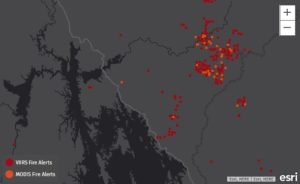Rangers in Thailand are fire fighting enormous blazes across the north of the country. As this year’s fire season hits harder than ever, lack of skilled rangers due to COVID-19 has meant the involvement of the Thai army. Hear from the Freeland team in Khao Laem National Park as they battle the fires across the park.
In Thailand the northeast monsoon occurs between October and May, the west southwest monsoons rotate 180 degrees and bring cool dry air southwards from China. During this dry season period, rainfall is rare and the whole country north of the Isthmus of Kra experiences unbearably dry conditions.
During this period slowly forests dry, leave fall off the deciduous trees and water in the forests becomes scarce, making life hard for wildlife and patrolling park rangers during the hottest of times, when temperatures can rise to 40 degrees centigrade. In many mountainous areas, springs continue to run until late into the dry season and these support the wildlife remaining in those areas.
The dry season is a quiet time for many farmers, as there are no crops to tend and so this is the period they tend to forage for wild fruit, vegetables and poach wildlife. Some farmers graze cattle in the forests and they burn areas to clear trees, open the land and to encourage new grass for their cows and buffalo[1]. Often poachers set fires for the same reasons, as new grass also brings down wild ungulates and makes shooting them easier, then the poachers don’t have to walk long distances to track and shoot wildlife. Often poachers set fires as distractions, so as the rangers are busy putting out fires, they can confidently poach in other areas.
There is also a mistaken belief that fire encourages mushroom growth[2], a myth recently disproven in a paper that demonstrated the varieties of mushrooms collected in mountainous forest areas in Thailand propagated equally well in burnt or unburnt areas.
Some fires are simply set by arsonists looking for a thrill[3].
Using Global Forest Watch website we saw there were 871 VIIRS fire alerts around Khao Laem reported in the week of the 6th of April 2020. This was high compared to the same week in previous years.
In the inaccessible steep Karst limestone mountains of Khao Laem (and much of the Tenasserim mountains) it becomes impossible to put out fires and in some instances, they are left to burn out by themselves. As much of the forest is bamboo, this quickly regenerates once the rains return. However, over the years the larger trees get burnt at the bases and fires damages them little by little and after several seasons even huge trees are lost.
The Department of National Parks and The Royal Forest Department have officials on call the put out fires, if possible, however, this section staff have little in the way of equipment, or correct fireproof clothing and every year many are badly burnt, suffer serious smoke inhalation and in 2020 many have lost their lives. As a result of this serious situation, exacerbated by the current COVID-19 pandemic, the Thai army is now getting involved.
As each season is getting hotter and the dry seasons getting longer and almost no intermittent rain the fires are getting larger and the first season is becoming longer.
Mammals and birds can generally escape from the fires, but nesting birds, reptiles including tortoises and small mammals escape is not always possible. Each year many lose their lives.
[1] https://www.plantbasednews.org/news/thailand-forest-fires-livestock-land-clearing
[2] https://www.bangkokpost.com/thailand/special-reports/511036/amid-northern-haze-a-burning-desire-for-wealth
[3] https://www.chiangraitimes.com/thailand-national-news/forest-fires-in-northern-thailand-the-work-of-arsonists/



